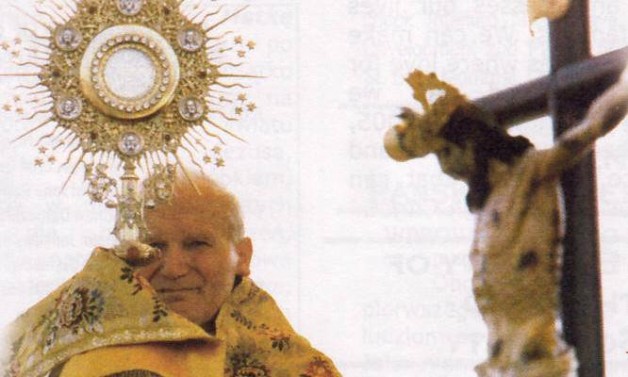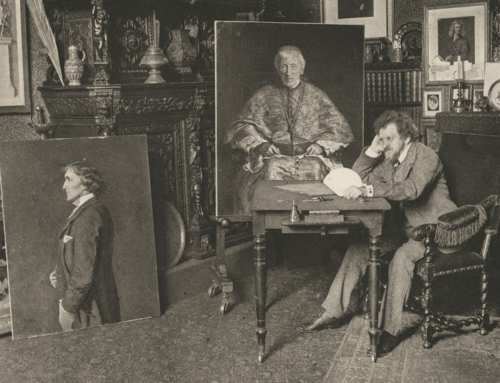Think of your home state. Most likely there is some “attraction” which would make it into a Rick Steves’ America but to which you as a “local” have never made a trip. Maybe this place is so familiar by site–a national hall-of-fame or historic landmark–that you even feel as if you know the place well enough. You probably even have some opinions about the place or directives you offer to visitors. And your ideas might even possess some accuracy and truth! But honestly, how well is your view informed? Is it open to be surpassed by a wider truth?
Having passed the National Shrine of St. John Paul II in Northeast Washington, DC, several times, I had formed my own pre-conceptions. Too modern in appearance and non-churchy to help this friar! Providentially, a break from classes and some good reviews of the new exhibit inside on the life of the saintly Pole prompted me to see what the interior held in store. Making a pilgrimage would give me the chance to honor a man with an evident devotion to the supreme Truth–God–and whose Christian witness has always inspired me. Here follows an overview and short reflection about a free local resource which should impress and enlighten anyone on a similar “school break.”
The JPII Shrine’s impressive downstairs exhibit contains nine galleries, complete with well-selected video footage, insightful quotes and testimonies, personal artifacts and manuscripts, numerous (maybe too many) voice-overs, and cool interactive technology for the kids. The exhibit will lead you through Karol Wojtyla’s life from his pious Polish childhood to his college and seminary years during the Nazi occupation, to his days as a young, mountaineering philosopher-priest.
Aspects of his deep and far-reaching thought are woven into the exhibit. These include his passion for the beauty of nature, his reverence for the dignity of the human person, and his promotion of solidarity among peoples. This was all driven by his deep friendship with Jesus Christ, “who reveals man to himself,” as John Paul loved to echo the phrase of Vatican II. Other parts of the display include John Paul’s participation in the Council, his papal inauguration, and the overwhelming number of journeys, meetings with world dignitaries, and exhortations to believers and nonbelievers which he made in the shoes of the Fisherman of Galilee.
The exhibit ends with a striking admission—spoiler alert!—that this man, who witnessed and lived so completely for Christ and did so much to make use of his remarkable talents, would end his life in the most humble circumstances. With the advance of Parkinson’s disease he could no longer move as he once did, with the strength, confidence, and finesse of a movie star. Nor was he even able to speak those words which welled up in his mystical and pastoral heart. In his helplessness he would witness first-hand to the power of suffering, which can purify and save men and women, who all too often find value only in what they’re able to do rather than who they are.
Here was a man whose commitment to truth did not cause him to despair at every injustice or difficulty he encountered. Rather, he exuded a patience, steadiness, and vision that could only be had from learning and adapting God’s own point of view. This outlook into Truth came as part of St. John Paul II’s personal conformity to the Truth-made-Flesh, Jesus Christ. This led him to a deep level of Christian discipleship which appeared in him to be the most natural and freeing commitment a person could make.
This transformation in Truth is something we all must undergo (gung-ho Dominican student brothers included!) if we are to discover the profound meaning of our existence. The end of the exhibit gives us some direction as to how to reach this level of freedom: the Rosary and the Eucharist. First, the exhibit contains a room with beautiful mosaics expressing the Mysteries of Light, introduced by John Paul to supplement his favorite devotion to Mary. In these Rosary meditations based on the ministry of Jesus, we receive glimpses of how Christ initiates our own elevation as beloved sons and daughters of God.
The second “help” offered here towards our spiritual transformation is the Holy Eucharist. This Sacrament defined our Saint’s life from his childhood, and it became the foundation of his priesthood. (Notably, the upstairs level of the Shrine includes a chapel where Mass is said daily and the Blessed Sacrament is reserved for silent prayer.) John Paul was known to have spent the first hours of each day in worship and silent contemplation of the Holy Eucharist. Once in the habit of gazing upon the consecrated Host and receiving the True Presence in Communion, how could any of us not be changed? How could we not be illumined by the same Jesus who brings life and light to the human race (Jn 1)?
I end with a story of John Paul that inspires me to more deeply invest myself in these privileged gifts we have as Catholics–one more hint from the Pope who spent his life to assist our transformation in truth. To catch his meaning, you might have to whisper it aloud: When Pope John Paul was once asked why he woke up so early each morning, he responded simply with a knowing twinkle in his eye, “I like to see the sun rise.” May a visit to this Shrine provide you with a similar orientation.
✠
Image: St. John Paul II







